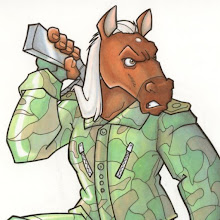The Cardanian Navy utilizes many salvaged and refurbished boats from before the Crash in their patrols and defense of the Cardanian coast line and it's many rivers. Generic Patrol Boat (Light)
Generic Patrol Boat (Light)
Engine: Internal Combustion
Speed: (Cruise) 25mph / (Max) 35mph [Speed Class 2 30/20]
Range: 250 Miles
Hull Length: 30'
Crew: 4 (Captain, 2x Gunners, Mechanic)
SDC: 300
AR: 12
Armaments:
1) (Bow) .50 cal -- 315 degree forward arc Dmg: 1D6x10
2) (Aft) .50 cal -- 315 degree rear arc Dmg: 1D6x10
3) (Midship) Mortar -- 360 degree Dmg: varies
4) (optional) Grenade Launcher, M60
Other Standard Equipment:
- Radar
- Sonar/Depth Guage
- Searchlight
- Radio, Mid-Range



